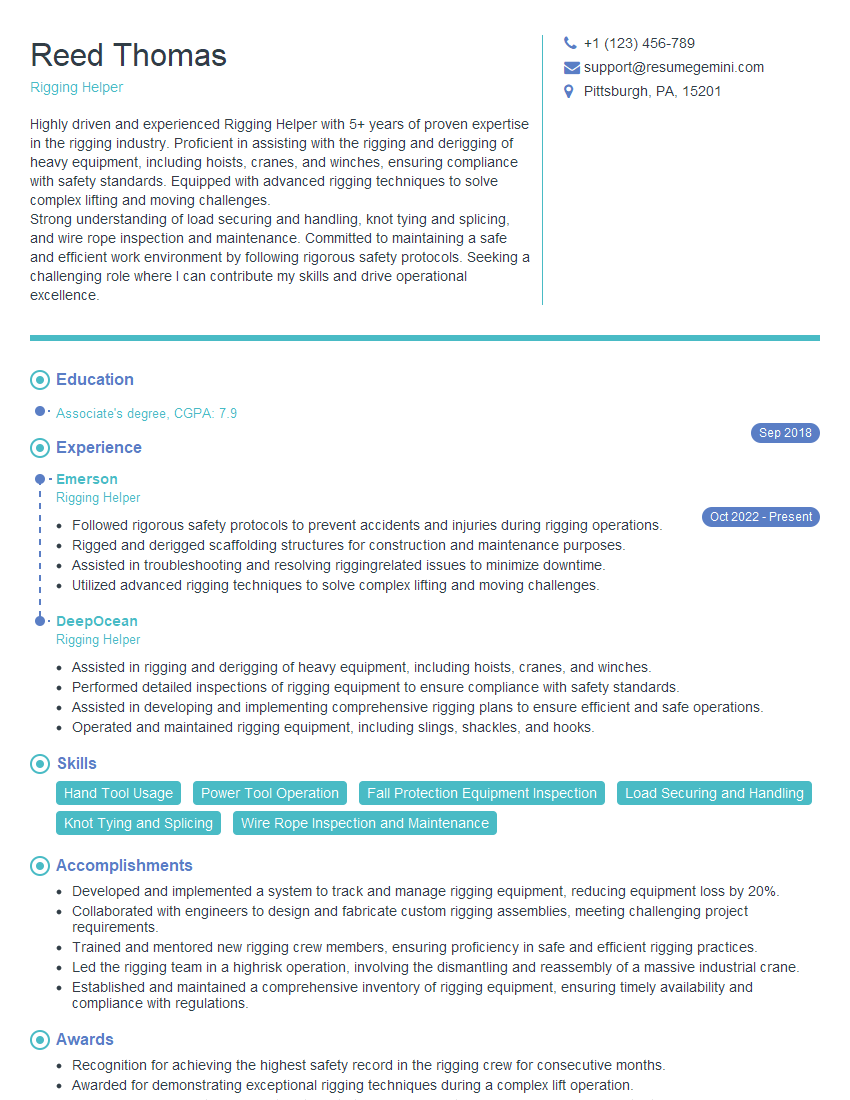Are you a seasoned Rigging Helper seeking a new career path? Discover our professionally built Rigging Helper Resume Template. This time-saving tool provides a solid foundation for your job search. Simply click “Edit Resume” to customize it with your unique experiences and achievements. Customize fonts and colors to match your personal style and increase your chances of landing your dream job. Explore more Resume Templates for additional options.

Reed Thomas
Rigging Helper
Summary
Highly driven and experienced Rigging Helper with 5+ years of proven expertise in the rigging industry. Proficient in assisting with the rigging and derigging of heavy equipment, including hoists, cranes, and winches, ensuring compliance with safety standards. Equipped with advanced rigging techniques to solve complex lifting and moving challenges.
Strong understanding of load securing and handling, knot tying and splicing, and wire rope inspection and maintenance. Committed to maintaining a safe and efficient work environment by following rigorous safety protocols. Seeking a challenging role where I can contribute my skills and drive operational excellence.
Education
Associate’s degree
September 2018
Skills
- Hand Tool Usage
- Power Tool Operation
- Fall Protection Equipment Inspection
- Load Securing and Handling
- Knot Tying and Splicing
- Wire Rope Inspection and Maintenance
Work Experience
Rigging Helper
- Followed rigorous safety protocols to prevent accidents and injuries during rigging operations.
- Rigged and derigged scaffolding structures for construction and maintenance purposes.
- Assisted in troubleshooting and resolving riggingrelated issues to minimize downtime.
- Utilized advanced rigging techniques to solve complex lifting and moving challenges.
Rigging Helper
- Assisted in rigging and derigging of heavy equipment, including hoists, cranes, and winches.
- Performed detailed inspections of rigging equipment to ensure compliance with safety standards.
- Assisted in developing and implementing comprehensive rigging plans to ensure efficient and safe operations.
- Operated and maintained rigging equipment, including slings, shackles, and hooks.
Accomplishments
- Developed and implemented a system to track and manage rigging equipment, reducing equipment loss by 20%.
- Collaborated with engineers to design and fabricate custom rigging assemblies, meeting challenging project requirements.
- Trained and mentored new rigging crew members, ensuring proficiency in safe and efficient rigging practices.
- Led the rigging team in a highrisk operation, involving the dismantling and reassembly of a massive industrial crane.
- Established and maintained a comprehensive inventory of rigging equipment, ensuring timely availability and compliance with regulations.
Awards
- Recognition for achieving the highest safety record in the rigging crew for consecutive months.
- Awarded for demonstrating exceptional rigging techniques during a complex lift operation.
- Received commendation for contributions to the development of new rigging procedures that enhanced efficiency.
Certificates
- OSHA 10-Hour Construction Safety
- Rigging and Crane Safety Certification
- First Aid and CPR
- ANSI/ASSP A10.48 Standard for Rigging
Career Expert Tips:
- Select the ideal resume template to showcase your professional experience effectively.
- Master the art of resume writing to highlight your unique qualifications and achievements.
- Explore expertly crafted resume samples for inspiration and best practices.
- Build your best resume for free this new year with ResumeGemini. Enjoy exclusive discounts on ATS optimized resume templates.
How To Write Resume For Rigging Helper
- Highlight your experience and skills in a clear and concise manner.
- Showcase your knowledge of relevant safety regulations and industry standards.
- Include specific examples of your involvement in complex rigging projects.
- Demonstrate your commitment to safety and adherence to industry best practices.
Essential Experience Highlights for a Strong Rigging Helper Resume
- Assisted in the rigging and derigging of heavy equipment, including hoists, cranes, and winches.
- Performed detailed inspections of rigging equipment to ensure compliance with safety standards.
- Assisted in developing and implementing comprehensive rigging plans to ensure efficient and safe operations.
- Operated and maintained rigging equipment, including slings, shackles, and hooks.
- Followed rigorous safety protocols to prevent accidents and injuries during rigging operations.
- Rigged and derigged scaffolding structures for construction and maintenance purposes.
- Assisted in troubleshooting and resolving rigging-related issues to minimize downtime.
- Utilized advanced rigging techniques to solve complex lifting and moving challenges.
Frequently Asked Questions (FAQ’s) For Rigging Helper
What are the primary responsibilities of a Rigging Helper?
Rigging Helpers assist in the rigging and derigging of heavy equipment, ensuring compliance with safety standards and assisting in developing and implementing rigging plans.
What skills are required for success as a Rigging Helper?
Essential skills include knowledge of hand tool usage, power tool operation, fall protection equipment inspection, load securing, and handling, knot tying, splicing, wire rope inspection, and maintenance.
What qualifications are necessary to become a Rigging Helper?
While a high school diploma is typically sufficient, many employers prefer candidates with an Associate’s degree in a relevant field, such as construction or engineering.
What is the expected salary range for a Rigging Helper?
The salary range for a Rigging Helper can vary based on experience, location, and employer, but can typically range from $40,000 to $60,000 per year.
What career advancement opportunities are available for Rigging Helpers?
With experience and additional training, Rigging Helpers can advance to roles such as Rigger, Crane Operator, or Safety Inspector.
What are the safety considerations for Rigging Helpers?
Rigging Helpers must follow rigorous safety protocols, including wearing appropriate personal protective equipment, adhering to load limits, and ensuring that equipment is properly inspected and maintained.
What is the importance of certification for Rigging Helpers?
While certification is not always required, obtaining certifications from organizations such as the National Commission for the Certification of Crane Operators (NCCCO) can enhance credibility and demonstrate proficiency in rigging operations.